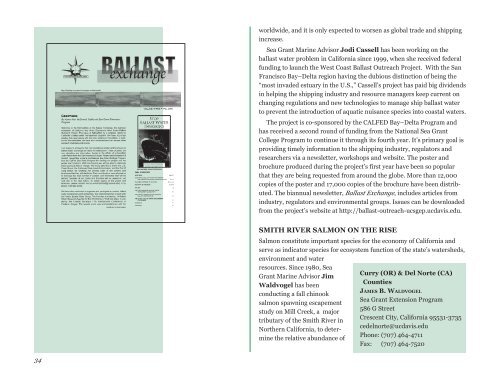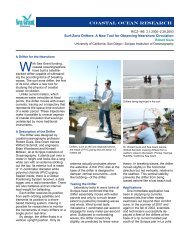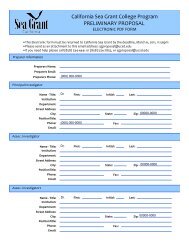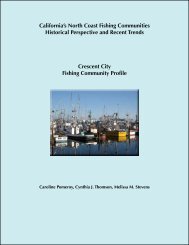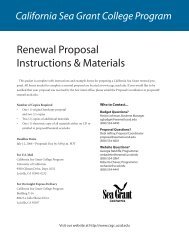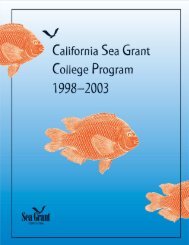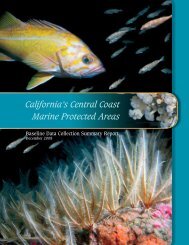2001â2002 - California Sea Grant - UC San Diego
2001â2002 - California Sea Grant - UC San Diego
2001â2002 - California Sea Grant - UC San Diego
Create successful ePaper yourself
Turn your PDF publications into a flip-book with our unique Google optimized e-Paper software.
worldwide, and it is only expected to worsen as global trade and shipping<br />
increase.<br />
<strong>Sea</strong> <strong>Grant</strong> Marine Advisor Jodi Cassell has been working on the<br />
ballast water problem in <strong>California</strong> since 1999, when she received federal<br />
funding to launch the West Coast Ballast Outreach Project. With the <strong>San</strong><br />
Francisco Bay–Delta region having the dubious distinction of being the<br />
“most invaded estuary in the U.S.,” Cassell’s project has paid big dividends<br />
in helping the shipping industry and resource managers keep current on<br />
changing regulations and new technologies to manage ship ballast water<br />
to prevent the introduction of aquatic nuisance species into coastal waters.<br />
The project is co-sponsored by the CALFED Bay–Delta Program and<br />
has received a second round of funding from the National <strong>Sea</strong> <strong>Grant</strong><br />
College Program to continue it through its fourth year. It’s primary goal is<br />
providing timely information to the shipping industry, regulators and<br />
researchers via a newsletter, workshops and website. The poster and<br />
brochure produced during the project’s first year have been so popular<br />
that they are being requested from around the globe. More than 12,000<br />
copies of the poster and 17,000 copies of the brochure have been distributed.<br />
The biannual newsletter, Ballast Exchange, includes articles from<br />
industry, regulators and environmental groups. Issues can be downloaded<br />
from the project’s website at http://ballast-outreach-ucsgep.ucdavis.edu.<br />
SMITH RIVER SALMON ON THE RISE<br />
Salmon constitute important species for the economy of <strong>California</strong> and<br />
serve as indicator species for ecosystem function of the state’s watersheds,<br />
environment and water<br />
resources. Since 1980, <strong>Sea</strong><br />
Curry (OR) & Del Norte (CA)<br />
<strong>Grant</strong> Marine Advisor Jim<br />
Counties<br />
Waldvogel has been<br />
JAMES<br />
conducting a fall chinook<br />
B. WALDVOGEL<br />
<strong>Sea</strong> <strong>Grant</strong> Extension Program<br />
salmon spawning escapement<br />
586 G Street<br />
study on Mill Creek, a major<br />
tributary of the Smith River in<br />
Crescent City, <strong>California</strong> 95531-3735<br />
cedelnorte@ucdavis.edu<br />
Northern <strong>California</strong>, to determine<br />
the relative abundance of<br />
Phone: (707) 464-4711<br />
Fax: (707) 464-7520<br />
34


